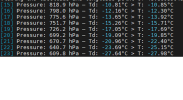While running WRF v4.5.2 with the electrification module (WRF-ELEC), I’ve come across something strange. During a period of lightning activity during a lake-effect snow event, the model output shows dewpoint temperatures significantly higher than the actual temperature, with relative humidity values around 113%. Other than this, the simulation seemed to have run smoothly with no other odd or impossible values.
I’m not sure why this is happening, and I don’t believe the electrification module should be affecting these thermodynamic variables. For reference, I’m using the NSSL 2-moment microphysics scheme, RRTMG for both shortwave and longwave radiation, and YSU for the PBL.
Has anyone encountered this before or have ideas on what might be causing it?
Thanks in advance!
I’m not sure why this is happening, and I don’t believe the electrification module should be affecting these thermodynamic variables. For reference, I’m using the NSSL 2-moment microphysics scheme, RRTMG for both shortwave and longwave radiation, and YSU for the PBL.
Has anyone encountered this before or have ideas on what might be causing it?
Thanks in advance!

